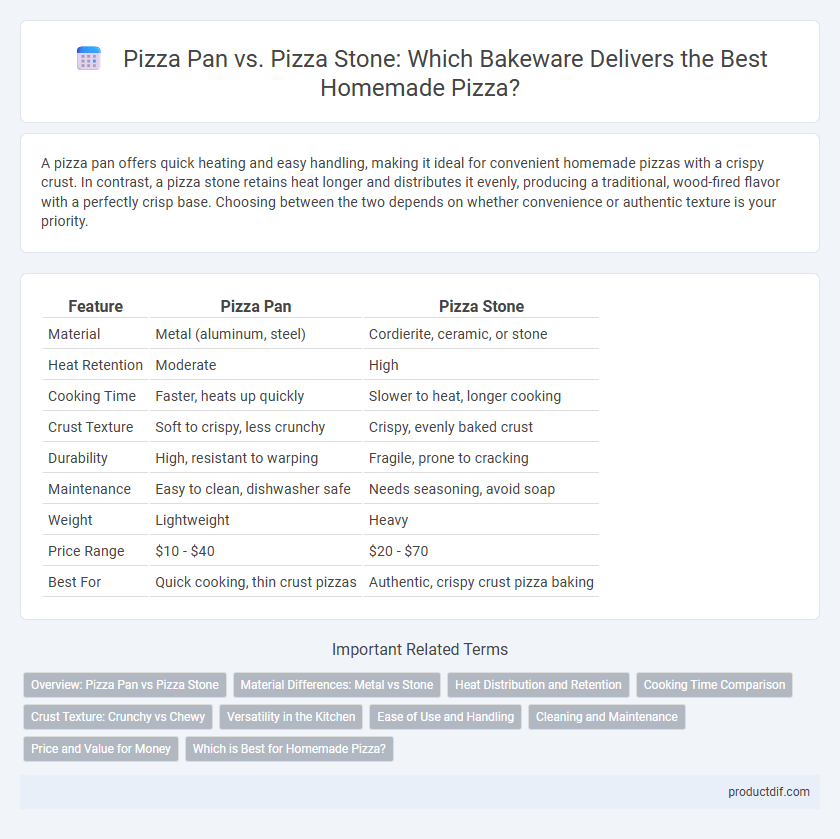A pizza pan offers quick heating and easy handling, making it ideal for convenient homemade pizzas with a crispy crust. In contrast, a pizza stone retains heat longer and distributes it evenly, producing a traditional, wood-fired flavor with a perfectly crisp base. Choosing between the two depends on whether convenience or authentic texture is your priority.
Table of Comparison
| Feature | Pizza Pan | Pizza Stone |
|---|---|---|
| Material | Metal (aluminum, steel) | Cordierite, ceramic, or stone |
| Heat Retention | Moderate | High |
| Cooking Time | Faster, heats up quickly | Slower to heat, longer cooking |
| Crust Texture | Soft to crispy, less crunchy | Crispy, evenly baked crust |
| Durability | High, resistant to warping | Fragile, prone to cracking |
| Maintenance | Easy to clean, dishwasher safe | Needs seasoning, avoid soap |
| Weight | Lightweight | Heavy |
| Price Range | $10 - $40 | $20 - $70 |
| Best For | Quick cooking, thin crust pizzas | Authentic, crispy crust pizza baking |
Overview: Pizza Pan vs Pizza Stone
Pizza pans and pizza stones each offer distinct benefits for homemade pizza; pizza pans provide even heat distribution with a non-stick surface ideal for quick cooking, while pizza stones simulate a brick oven by absorbing moisture and creating a crispier crust. Pizza stones typically require preheating in the oven to reach high temperatures and retain heat, resulting in a more authentic, evenly cooked crust. Pizza pans are more versatile and convenient, suitable for direct oven use without extensive preheating and easier cleanup.
Material Differences: Metal vs Stone
Metal pizza pans, typically made from aluminum or steel, offer excellent heat conductivity and quick preheating, resulting in a crispier crust with less cooking time. Stone pizza stones, often crafted from cordierite or ceramic, provide even heat distribution and moisture absorption, which helps create an authentic, wood-fired texture and prevents sogginess. The choice between metal and stone materials affects heat retention, cooking speed, and the final crust texture in homemade pizza preparation.
Heat Distribution and Retention
Pizza stones excel in even heat distribution and superior heat retention, ensuring a uniformly crispy crust by absorbing moisture and radiating consistent heat throughout baking. Pizza pans, typically made from metal, heat up faster but often exhibit uneven heat distribution, which can lead to hotspots and less consistent cooking results. For optimal bakeware performance, a pizza stone provides steady thermal mass that maintains high temperatures longer, while a metal pan offers quicker responsiveness but less uniform heat retention.
Cooking Time Comparison
Pizza stones retain heat better than pizza pans, resulting in a more evenly cooked crust and typically shorter cooking times, often around 7 to 10 minutes at high temperatures. Pizza pans, made from metal, heat up quickly but may cook pizza in slightly longer times, about 10 to 15 minutes, due to less heat retention and distribution. The material and thickness of each bakeware type significantly influence the overall cooking efficiency and final pizza texture.
Crust Texture: Crunchy vs Chewy
Pizza pans typically produce a crunchier crust due to their solid metal construction, which heats evenly and promotes browning. In contrast, pizza stones absorb moisture from the dough, resulting in a chewier, more artisanal texture with a slightly thicker crust. Choosing between a pizza pan and pizza stone depends on the preferred crust texture and baking style.
Versatility in the Kitchen
Pizza pans offer greater versatility in the kitchen, accommodating various crust types and toppings with ease due to their uniform heat distribution and non-stick surfaces. Pizza stones excel at creating crispy, evenly baked crusts by absorbing moisture and retaining high heat, ideal for traditional-style pizzas and breads. Both tools enhance baking performance but serve distinct purposes depending on whether versatility or authentic texture is the priority.
Ease of Use and Handling
Pizza pans offer superior ease of use and handling due to their lightweight design and straightforward cleaning process compared to pizza stones, which require preheating and careful handling to avoid cracking. Pizza pans typically have handles or rims, enhancing grip and maneuverability, while pizza stones can be bulky and heavy, making them less convenient for frequent use. For novice cooks or those valuing quick preparation and cleanup, pizza pans provide a more user-friendly option in the bakeware category.
Cleaning and Maintenance
Pizza pans typically feature non-stick coatings that allow for easy cleaning with warm soapy water and a soft cloth, minimizing residue buildup. In contrast, pizza stones absorb oils and moisture during baking, requiring thorough brushing and air drying to prevent cracking and mold growth. Regular maintenance of pizza stones involves avoiding soap and sudden temperature changes to preserve their porous surface and longevity.
Price and Value for Money
Pizza pans typically cost between $15 and $30, offering affordable and durable options made from materials like steel or aluminum. Pizza stones range from $25 to $60, providing superior heat retention and crispier crusts, which many consider worth the higher investment. Choosing between a pizza pan and stone depends on balancing budget constraints with desired cooking performance and long-term value.
Which is Best for Homemade Pizza?
Pizza pans provide even heat distribution and a non-stick surface ideal for quick, crispy crusts in homemade pizza, while pizza stones absorb moisture and retain high temperatures, mimicking a brick oven for a chewier, authentic texture. For faster cooking and ease of use, a pizza pan serves best, but for those seeking traditional restaurant-quality results, a pizza stone offers superior heat retention and crust development. Home cooks balancing convenience and texture often choose pizza stones for their ability to enhance flavor and replicate professional baking conditions.
Pizza pan vs pizza stone Infographic

 productdif.com
productdif.com